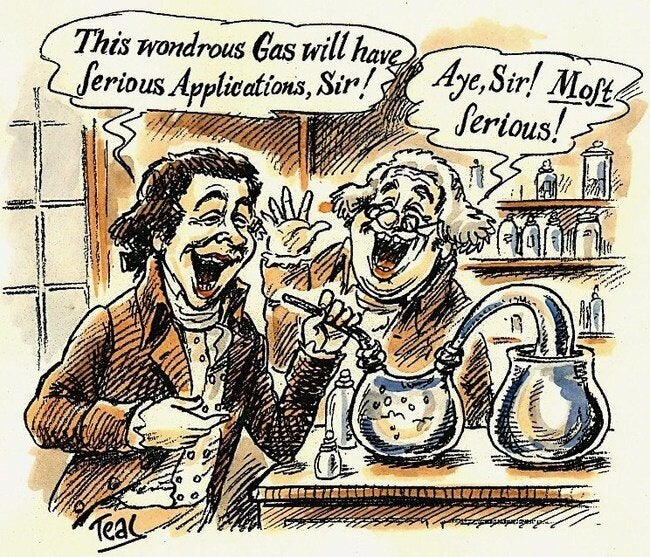
Home Office figures released recently suggest that in the past twelve months more than 350,000 young people have used nitrous oxide - also known as 'laughing gas', and 'hippie crack' - to achieve a legal high. This makes it the second-most popular drug in the UK after cannabis, and even Prince Harry was said to have had a toot on it three years ago. In spite of tabloid frothing about this being a dangerous 'new' phenomenon, however, our ancestors got there long before us, and one famous Gin Lane Gazette character made 'laughing gas parties' a fashionable pursuit.
In the late 1790s, the precocious and charismatic young scientist Humphry Davy (1778-1829) undertook experiments with nitrous oxide at Dr. Thomas Beddoes's Pneumatic Institution. Although this sounds like a Georgian prototype of Kwik Fit, it was actually a laboratory in wealthy Bristol, where the effects of inhaled gases on various diseases such as consumption (now known as tuberculosis) were investigated. One in four Britons was killed by TB, and a cure would have been a huge benefit, but the results of Davy's investigations led him away from medicine towards entirely new realms of possibility.
Davy began taking nitrous oxide regularly, and recorded its thrilling and highly pleasurable effects on body and mind. He recorded how it sharpened all the senses, he was known to cry out and skip around the room when under its influence. He penned effusive poetry about its wondrous qualities, and claimed that it would offer new understanding of the secrets and workings of the brain. He also stirred up controversy by suggesting that human emotions were engendered by chemicals in the body, not the influence of the Almighty.
Davy developed a breathing chamber that allowed easy use of laughing gas. He persuaded his acquaintances to give it a try, and his friend, the poet Robert Southey, became an enthusiastic user. After having a puff, an excited Southey wrote to an associate, 'O excellent air-bag!...I am sure the air in heaven must be this wonder-working gas of delight'. Southey and his friend Samuel Taylor Coleridge had a penchant for dabbling with mind-altering substances, and for alternative lifestyles. The pair had considered setting up a Utopian community in America called a 'Pantisocracy' - from the Greek meaning 'equal government by and for all' - but then decided a site in Wales would be more practical, before finally abandoning the project altogether.
Coleridge joined Southey and Davy in their experiments with laughing gas, and he claimed that by inhaling it he had attained a state of unmingled pleasure, greater than anything he had previously achieved. He remarked that when he tried the gas he felt 'a highly pleasurable sensation of warmth...The only motion which I felt inclined to make, was that of laughing at those who were looking at me'.
Davy published his findings and experiences in 1800, and even suggested that nitrous oxide could be used as an anaesthetic in surgical procedures, although his proposal was ignored for forty years. The Pneumatic Institution soon became a fashionable establishment, with poets, scientists, playwrights, surgeons, and many public figures flocking to Davy's laughing gas parties. By the use of nitrous oxide, they hoped to give their wits free rein to enjoy the most elevated spheres of human thought and fancy.
Davy's interests finally shifted to other fields of endeavour, and he was the first scientist to use the word 'element' in its modern chemical sense. His most famous legacy is the safety lamp he invented in 1815 to assist with deep coal-mining. Before its anaesthetic applications were finally exploited in the 1840s, the use of laughing gas was confined to sideshows in travelling fairs, and entertainments in theatres such as the Adelphi. Volunteers would be coaxed onto the stage by a showman, inhale the gas, and frolic about to the amusement of the audience.
The Gin Lane Gazetteon sale now!